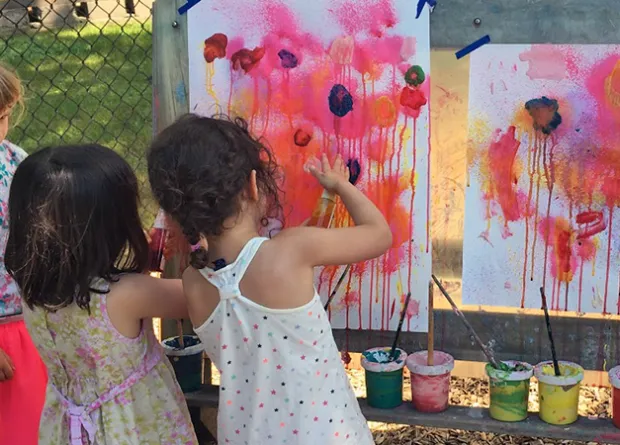Visual Arts Program
The visual arts studio at Fort Hill is a centrally located space within the school available for all preschool children to visit on a daily basis. For an extended period of time each day, children from each preschool classroom are given the agency to choose when they would like to visit the arts studio. While in the space, visitors are free to explore as they wish, and leave when they are ready. At Fort Hill, we believe that this system helps to create an environment within the school where children from each classroom can work collaboratively and creatively at their own pace.
The art studio is unique, in part because of the materials that are available to children. The studio teacher offers traditional and high quality materials such as watercolors, paint, pencils, clay, etc. However, it is not uncommon to find recycled materials, natural objects, and other items conducive to visual expression or language, yet not usually seen in a preschool art space. It is our philosophy that access to and experience with open-ended materials provide the space for multi-modal expression and discovery. The unique presentation and offering of a wide variety of materials allow children to freely explore innovative ideas.
The studio teacher brings experience and knowledge of both the arts as well as child development and uses this knowledge to create thoughtful and beautifully presented provocations inspired by children’s observed interests. She inspires interdisciplinary work to take place which strengthens formed connections to their learning in the classroom, other children’s work, their prior knowledge, and their experiences both in and outside of school. As they make these connections, their understanding of their experiences and their world, grow.
Ready to apply? Learn more.

The Hundred Languages of Children
As children make hypotheses, explore their environment, and discover connections and meanings, they use many media to express and communicate their discoveries. In Reggio Emilia, Italy, the educators refer to these as the "hundred languages of children." At Fort Hill, specialists in visual arts and music support the teachers and children in using many languages. The specialists work with all the children in the school—infants, toddlers and preschoolers.
No way.
The hundred is there.
The child is made of one hundred.
The child has a hundred languages
a hundred hands
a hundred thoughts
a hundred ways of thinking
of playing, of speaking.
A hundred.
Always a hundred
ways of listening
of marveling, of loving
a hundred joys
for singing and understanding
a hundred worlds to discover
a hundred worlds to invent
a hundred worlds to dream.
The child has a hundred languages
(and a hundred hundred hundred more)
but they steal ninety-nine.
The school and the culture
separate the head from the body.
They tell the child to think without hands
to do without head
to listen and not to speak
to understand without joy
to love and to marvel
only at Easter and Christmas.
They tell the child
to discover the world already there
and of the hundred
they steal ninety-nine.
They tell the child that work and play
reality and fantasy
science and imagination
sky and earth
reason and dream
are things
that do not belong together.
And thus they tell the child
that the hundred is not there.
The child says
"No way. The hundred is there."
Loris Malaguzzi (translated by Lella Gandini)